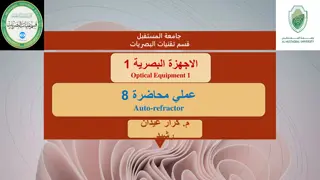Understanding Prescriptions: Key Components and Importance
A prescription is a crucial written order from a healthcare provider to a pharmacist, outlining specific medications for a patient. Key parts include Superscription, Inscription, Subscription, and Signatura, each serving distinct roles in the prescription process. Physician office details and patient information are also essential components. Understanding the components and handling of prescriptions is vital for effective healthcare delivery and patient safety.
Download Presentation

Please find below an Image/Link to download the presentation.
The content on the website is provided AS IS for your information and personal use only. It may not be sold, licensed, or shared on other websites without obtaining consent from the author. Download presentation by click this link. If you encounter any issues during the download, it is possible that the publisher has removed the file from their server.
E N D
Presentation Transcript
Contents Definition, Parts of prescription, Handling of Prescription and
What is a Prescription? It is an order written by a physician, dentist, veterinarian or a registered medical practitioner (RMP) to a pharmacist to compound and dispense a specific drug for the patient. OR A prescription is a written order for medication, issued by a physician or RMP. Prescription is the relationship between physician and pharmacist. The word prescription is derived from the Latin term praescriptus. (Prae before and scribere- Prescription means to write before which means a prescription had to be written before a drug could be compounded and administered to a patient. meaning to write ).
Main Parts of Prescription Superscription (symbol ) Inscription (Medication prescribed)- Main part of the prescription Subscription(Direction to Pharmacist/Dispenser ) Signatura or Transcription (Direction for Patient) Prescriber s signature and registration number.
Physician (Prescriber) office Information: Information about physician is essential so that the patient could be contact in emergency. Following information is mentioned on the prescription Doctor's or office name. Address with phone number and e-mail. Prescription number, (required when calling the pharmacy for a refill)
Date It helps a pharmacist to find out the date of prescribing. It also helps in know when the medicines were last dispensed if the prescription is brought for redispens. In case of habit forming drug the date prevents the misuse of the drug by the patient
PATIENT INFORMATION PATIENT INFORMATION (Name, Age, Sex and Address of the Patient) Name and address of the patient for identification purpose. Age and sex of the patient is required for child patient to check the prescribed dose.
SUPERSCRIPTION (symbol ) It is represented by (Latin term) recipe which means take thou or you take . In olden days, the symbol was considered to be originated from the sign of Jupiter. Jupiter is the Greek God of healing. This symbol was use for requesting God for the quick recovery of the patient
INSCRIPTION (Medication prescribed) It is the main part of the prescription. It contains the names and quantities of the prescribed medicaments. The medicament may be official preparation or nonofficial preparation. a.) Official preparation (i.e. from pharmacopoeia) Only name of the preparation is written E.g. Piperazine Citrate Elixir IP b.) Nonofficial preparation- Quantity of each ingredient will be given and type of preparation will also be given
SUBSCRIPTION (Direction to Pharmacist) In this part the prescriber gives direction to the pharmacista) Regarding the dosage form to be prepared. b) Number of doses to be dispensed.
SIGNATURA (Direction for Patient) To be placed on the label. It is usually written as Sig. . The signatura written in english and use some Latin abbreviations like t.i.d (thrice a day), b.i.d (twice a day) and o.d (once a day).
Instructions should be written on the label of container so that the patient can follow them. The instructions may include a) Quantity to be taken(dose of drug) b) Frequency and timing of administration of the preparation (dose interval) c) Route of administration d) Special instruction (if any)
PRESCRIBERS SIGNATURE AND REGISTRATION NUMBER The prescription must be signed by the prescriber by his / her own hand. Registration number should be written in the case of dangerous and habit forming drugs.























